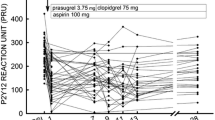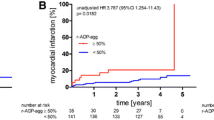Abstract
Background
Stent thrombosis occurs frequently within the first weeks after cessation of longterm clopidogrel therapy. We investigated if rebound platelet hyperreactivity occurs to provide a mechanism for this clinical observation.
Methods
ADP- and TRAP-induced platelet aggregation was measured by impedance aggregometry in 28 patients with coronary stent implantation (observational group, OG) before and 1, 2, 6 and 17 weeks after clopidogrel cessation. Data were compared intraindividually as well as to 67 controls (control group, CG).
Results
On-clopidogrel platelet activity was significantly reduced (ADP-stimulation, OG vs. CG, 30 ± 3 U vs. 67 ± 3 U, p < 0.001) and reached control levels 1 week after clopidogrel cessation (ADP-stimulation, OG vs. CG, 70 ± 4 U vs. 67 ± 3 U, p = n.s.). Most patients (57%) showed a significant platelet hyperaggregation after 2 weeks (ADP, OG vs. CG, 83 ± 6 U vs. 67 ± 3 U, p = 0.02) to 6 weeks (ADP, OG vs. CG, 85 ± 5 U vs. 67 ± 3 U, p = 0.01) post-cessation. This temporary hyperaggregability was also observed in intra-individual time courses (ADP, 2 vs. 17 weeks, 83 ± 6 U vs. 73 ± 4 U, p = 0.007; 6 vs. 17 weeks, 85 ± 5 U vs. 73 ± 4 U, p = 0.0002). After 17 weeks post-cessation, ADP-induced platelet aggregation returned towards physiological levels. The total capacity of platelet aggregability as reflected by stimulation with thrombin receptor activating peptide (TRAP) was not different between time points confirming a clopidogrel-specific rebound effect.
Conclusion
Abrupt clopidogrel cessation after 1 year of clopidogrel treatment results in ADP specific platelet hyperreactivity between 2 and 6 weeks post withdrawal. This mechanism may contribute to explain increased rates of stent thrombosis at this time as it was observed in clinical studies.



Similar content being viewed by others
References
Airoldi F, Colombo A, Morici N, Latib A, Cosgrave J, Buellesfeld L, Bonizzoni E, Carlino M, Gerckens U, Godino C, Melzi G, Michev I, Montorfano M, Sangiorgi GM, Qasim A, Chieffo A, Briguori C, Grube E (2007) Incidence and predictors of drug-eluting stent thrombosis during and after discontinuation of thienopyridine treatment. Circulation 116:745–754
Buonamici P, Marcucci R, Migliorini A, Gensini GF, Santini A, Paniccia R, Moschi G, Gori AM, Abbate R, Antoniucci D (2007) Impact of platelet reactivity after clopidogrel administration on drug-eluting stent thrombosis. J Am Coll Cardiol 49:2312–2317
Cutlip DE, Baim DS, Ho KK, Popma JJ, Lansky AJ, Cohen DJ, Carrozza JP Jr, Chauhan MS, Rodriguez O, Kuntz RE (2001) Stent thrombosis in the modern era: a pooled analysis of multicenter coronary stent clinical trials. Circulation 103:1967–1971
Cutlip DE, Windecker S, Mehran R, Boam A, Cohen DJ, van Es GA, Steg PG, Morel MA, Mauri L, Vranckx P, McFadden E, Lansky A, Hamon M, Krucoff MW, Serruys PW (2007) Clinical end points in coronary stent trials: a case for standardized definitions. Circulation 115:2344–2351
Diehl P, Olivier C, Halscheid C, Helbing T, Bode C, Moser M (2010) Clopidogrel affects leukocyte dependent platelet aggregation by P2Y12 expressing leukocytes. Basic Res Cardiol 105:379–387
Frelinger AL 3rd, Barnard MR, Fox ML, Michelson AD (2010) The platelet activity after clopidogrel termination (PACT) study. Circ Cardiovasc Interv 3:442–449
Geisler T, Zurn C, Simonenko R, Rapin M, Kraibooj H, Kilias A, Bigalke B, Stellos K, Schwab M, May AE, Herdeg C, Gawaz M (2010) Early but not late stent thrombosis is influenced by residual platelet aggregation in patients undergoing coronary interventions. Eur Heart J 31:59–66
Hechler B, Zhang Y, Eckly A, Cazenave JP, Gachet C, Ravid K (2003) Lineage-specific overexpression of the P2Y1 receptor induces platelet hyper-reactivity in transgenic mice. J Thromb Haemost 1:155–163
Ho PM, Peterson ED, Wang L, Magid DJ, Fihn SD, Larsen GC, Jesse RA, Rumsfeld JS (2008) Incidence of death and acute myocardial infarction associated with stopping clopidogrel after acute coronary syndrome. JAMA 299:532–539
Ho PM, Tsai TT, Wang TY, Shetterly SM, Clarke CL, Go AS, Sedrakyan A, Rumsfeld JS, Peterson ED, Magid DJ (2010) Adverse events after stopping clopidogrel in post-acute coronary syndrome patients: Insights from a large integrated healthcare delivery system. Circ Cardiovasc Qual Outcomes 3:303–308
Hoffmann R, Klinker H, Adamu U, Kelm M, Blindt R (2009) The risk of definitive stent thrombosis is increased after “off-label” stent implantation irrespective of drug-eluting stent or bare-metal stent use. Clin Res Cardiol 98:549–554
Iakovou I, Schmidt T, Bonizzoni E, Ge L, Sangiorgi GM, Stankovic G, Airoldi F, Chieffo A, Montorfano M, Carlino M, Michev I, Corvaja N, Briguori C, Gerckens U, Grube E, Colombo A (2005) Incidence, predictors, and outcome of thrombosis after successful implantation of drug-eluting stents. JAMA 293:2126–2130
Ibrahim K, Hass N, Kolschmann S, Strasser RH, Braun-Dullaeus RC (2008) Reversible clopidogrel resistance due to right ventricular myocardial infarction: risk factor of recurrent stent thrombosis? Clin Res Cardiol 97:797–800
Jeremias A, Sylvia B, Bridges J, Kirtane AJ, Bigelow B, Pinto DS, Ho KK, Cohen DJ, Garcia LA, Cutlip DE, Carrozza JP Jr (2004) Stent thrombosis after successful sirolimus-eluting stent implantation. Circulation 109:1930–1932
Johnson A, Dovlatova N, Heptinstall S (2008) Multiple electrode aggregometry and P2Y(12) antagonists. Thromb Haemost 99:1127–1129
Kushner FG, Hand M, Smith SC Jr, King SB 3rd, Anderson JL, Antman EM, Bailey SR, Bates ER, Blankenship JC, Casey DE Jr, Green LA, Hochman JS, Jacobs AK, Krumholz HM, Morrison DA, Ornato JP, Pearle DL, Peterson ED, Sloan MA, Whitlow PL et al (2009) 2009 Focused updates: ACC/AHA guidelines for the management of patients with ST-elevation myocardial infarction (updating the 2004 guideline and 2007 focused update) and ACC/AHA/SCAI guidelines on percutaneous coronary intervention (updating the 2005 guideline and 2007 focused update): a report of the American College of Cardiology Foundation/American Heart Association Task Force on practice guidelines. Circulation 120:2271–2306
Mauri L, Kereiakes DJ, Normand SL, Wiviott SD, Cohen DJ, Holmes DR, Bangalore S, Cutlip DE, Pencina M, Massaro JM (2010) Rationale and design of the dual antiplatelet therapy study, a prospective, multicenter, randomized, double-blind trial to assess the effectiveness and safety of 12 versus 30 months of dual antiplatelet therapy in subjects undergoing percutaneous coronary intervention with either drug-eluting stent or bare metal stent placement for the treatment of coronary artery lesions. Am Heart J 160(6):1035–1041
Ong AT, McFadden EP, Regar E, de Jaegere PP, van Domburg RT, Serruys PW (2005) Late angiographic stent thrombosis (LAST) events with drug-eluting stents. J Am Coll Cardiol 45:2088–2092
Oury C, Kuijpers MJ, Toth-Zsamboki E, Bonnefoy A, Danloy S, Vreys I, Feijge MA, De Vos R, Vermylen J, Heemskerk JW, Hoylaerts MF (2003) Overexpression of the platelet P2X1 ion channel in transgenic mice generates a novel prothrombotic phenotype. Blood 101:3969–3976
Pfisterer M, Brunner-La Rocca HP, Buser PT, Rickenbacher P, Hunziker P, Mueller C, Jeger R, Bader F, Osswald S, Kaiser C (2006) Late clinical events after clopidogrel discontinuation may limit the benefit of drug-eluting stents: an observational study of drug-eluting versus bare-metal stents. J Am Coll Cardiol 48:2584–2591
Shanker G, Kontos JL, Eckman DM, Wesley-Farrington D, Sane DC (2006) Nicotine upregulates the expression of P2Y12 on vascular cells and megakaryoblasts. J Thromb Thrombolysis 22:213–220
Sibbing D, Braun S, Jawansky S, Vogt W, Mehilli J, Schomig A, Kastrati A, von Beckerath N (2008) Assessment of ADP-induced platelet aggregation with light transmission aggregometry and multiple electrode platelet aggregometry before and after clopidogrel treatment. Thromb Haemost 99:121–126
Sibbing D, Morath T, Braun S, Stegherr J, Mehilli J, Vogt W, Schomig A, Kastrati A, von Beckerath N (2010) Clopidogrel response status assessed with Multiplate point-of-care analysis and the incidence and timing of stent thrombosis over six months following coronary stenting. Thromb Haemost 103(1):151–159
Sibbing D, Stegherr J, Braun S, Mehilli J, Schulz S, Seyfarth M, Kastrati A, von Beckerath N, Schomig A (2009) A double-blind, randomized study on prevention and existence of a rebound phenomenon of platelets after cessation of clopidogrel treatment. J Am Coll Cardiol 55:558–565
Tolhurst G, Vial C, Leon C, Gachet C, Evans RJ, Mahaut-Smith MP (2005) Interplay between P2Y(1), P2Y(12), and P2X(1) receptors in the activation of megakaryocyte cation influx currents by ADP: evidence that the primary megakaryocyte represents a fully functional model of platelet P2 receptor signaling. Blood 106:1644–1651
Trenk D, Hochholzer W, Fromm MF, Chialda LE, Pahl A, Valina CM, Stratz C, Schmiebusch P, Bestehorn HP, Buttner HJ, Neumann FJ (2008) Cytochrome P450 2C19 681G > A polymorphism and high on-clopidogrel platelet reactivity associated with adverse 1-year clinical outcome of elective percutaneous coronary intervention with drug-eluting or bare-metal stents. J Am Coll Cardiol 51:1925–1934
van Werkum JW, Heestermans AA, Zomer AC, Kelder JC, Suttorp MJ, Rensing BJ, Koolen JJ, Brueren BR, Dambrink JH, Hautvast RW, Verheugt FW, ten Berg JM (2009) Predictors of coronary stent thrombosis: the Dutch Stent Thrombosis Registry. J Am Coll Cardiol 53:1399–1409
Weber AA, Braun M, Hohlfeld T, Schwippert B, Tschope D, Schror K (2001) Recovery of platelet function after discontinuation of clopidogrel treatment in healthy volunteers. Br J Clin Pharmacol 52:333–336
Wykrzykowska JJ, Warnholtz A, de Jaeger P, Curzen N, Oldroyd KG, Collet JP, Ten Berg JM, Rademaker T, Goedhart D, Lissens J, Kint PP, Serruys PW (2009) Effect of clopidogrel discontinuation at 1 year after drug eluting stent placement on soluble CD40L, P-selectin and C-reactive protein levels: DECADES (discontinuation effect of clopidogrel after drug eluting stent): a multicenter, open-label study. J Thromb Thrombolysis 28:410–417
Author information
Authors and Affiliations
Corresponding author
Electronic supplementary material
Below is the link to the electronic supplementary material.
392_2011_310_MOESM1_ESM.pdf
Supplemental figure 1: Overall platelet aggregability is not affected by clopidogrel cessation. Total platelet aggregability was not influenced by clopidogrel cessation, assessed by stimulation with Thrombin Receptor Activating Peptide (TRAP), and did not show a rebound effect. Thus, the ADP-induced platelet rebound effect seems to be related to the P2Y12 receptor pathway (PDF 236 kb)
392_2011_310_MOESM2_ESM.pdf
Supplemental figure 2: Rebound effect is not induced by changes in platelet counts. Platelet counts before and after clopidogrel cessation were within reference range and did not differ between time points. Hence, the post cessational rebound effect is not caused by differences in platelet counts (PDF 239 kb)
Rights and permissions
About this article
Cite this article
Diehl, P., Halscheid, C., Olivier, C. et al. Discontinuation of long term clopidogrel therapy induces platelet rebound hyperaggregability between 2 and 6 weeks post cessation. Clin Res Cardiol 100, 765–771 (2011). https://doi.org/10.1007/s00392-011-0310-7
Received:
Accepted:
Published:
Issue Date:
DOI: https://doi.org/10.1007/s00392-011-0310-7




